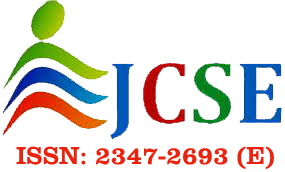TaxoFinder A Graph-Based Technique for Taxonomy Learning
Abhijeet Ashokrao Kadam1 , Shivputra Guruling Swami2
Section:Technical Paper, Product Type: Journal Paper
Volume-8 ,
Issue-4 , Page no. 129-132, Apr-2020
CrossRef-DOI: https://doi.org/10.26438/ijcse/v8i4.129132
Online published on Apr 30, 2020
Copyright © Abhijeet Ashokrao Kadam, Shivputra Guruling Swami . This is an open access article distributed under the Creative Commons Attribution License, which permits unrestricted use, distribution, and reproduction in any medium, provided the original work is properly cited.
View this paper at Google Scholar | DPI Digital Library
How to Cite this Paper
- IEEE Citation
- MLA Citation
- APA Citation
- BibTex Citation
- RIS Citation
IEEE Citation
IEEE Style Citation: Abhijeet Ashokrao Kadam, Shivputra Guruling Swami, “TaxoFinder A Graph-Based Technique for Taxonomy Learning,” International Journal of Computer Sciences and Engineering, Vol.8, Issue.4, pp.129-132, 2020.
MLA Citation
MLA Style Citation: Abhijeet Ashokrao Kadam, Shivputra Guruling Swami "TaxoFinder A Graph-Based Technique for Taxonomy Learning." International Journal of Computer Sciences and Engineering 8.4 (2020): 129-132.
APA Citation
APA Style Citation: Abhijeet Ashokrao Kadam, Shivputra Guruling Swami, (2020). TaxoFinder A Graph-Based Technique for Taxonomy Learning. International Journal of Computer Sciences and Engineering, 8(4), 129-132.
BibTex Citation
BibTex Style Citation:
@article{Kadam_2020,
author = {Abhijeet Ashokrao Kadam, Shivputra Guruling Swami},
title = {TaxoFinder A Graph-Based Technique for Taxonomy Learning},
journal = {International Journal of Computer Sciences and Engineering},
issue_date = {4 2020},
volume = {8},
Issue = {4},
month = {4},
year = {2020},
issn = {2347-2693},
pages = {129-132},
url = {https://www.ijcseonline.org/full_paper_view.php?paper_id=5089},
doi = {https://doi.org/10.26438/ijcse/v8i4.129132}
publisher = {IJCSE, Indore, INDIA},
}
RIS Citation
RIS Style Citation:
TY - JOUR
DO = {https://doi.org/10.26438/ijcse/v8i4.129132}
UR - https://www.ijcseonline.org/full_paper_view.php?paper_id=5089
TI - TaxoFinder A Graph-Based Technique for Taxonomy Learning
T2 - International Journal of Computer Sciences and Engineering
AU - Abhijeet Ashokrao Kadam, Shivputra Guruling Swami
PY - 2020
DA - 2020/04/30
PB - IJCSE, Indore, INDIA
SP - 129-132
IS - 4
VL - 8
SN - 2347-2693
ER -
| |
|
|
| 263 | 295 downloads | 188 downloads |
Abstract
Taxonomy is an essential process for gaining, sending, and classifying information, and also creating and using applications in several fields. To minimize humans, work to form the taxonomy learning from scratch and then increase the consistency of the taxonomy, now we suggest an approach to taxonomy learning, called TaxoFinder. TaxoFinder does three stages to construct a taxonomy automatically. Next, it distinguishes notions which are specific to the domain from a corpus of text. Later, it develops a graph describing how these definitions are connected at once depending on their co-occurrences. We will provide a technique for calculating strengths of associative between the concepts as the main method in TaxoFinder, which proves the strength and how tightly they have associated in the graphs, Using their similarities and spatial differences in sentences. Then lastly, have the TaxoFinder which uses a graph-analytical algorithm to trigger a taxonomy. TaxoFinder attempts to construct a taxonomy in such a way that to create a taxonomy, it enhances the associative strengths between the concepts in the graph. We test TaxoFinder on three separate domains using the gold standard evaluation: Mass-meetings emergency response, autism research and disorder domains. We evaluate TaxoFinder as the very effective subsumption method in this development, and it reveals that TaxoFinder was an efficient solution that successfully outperforms the subsumption process.
Key-Words / Index Term
Knowledge searching, Taxonomy learning, Taxonomy, TaxoFinder, keyword phrases
References
[1] K. Meijer, F. Frasincar, and F. Hogenboom, “A semantic approach for extracting domain taxonomies from text,” Decision Support Syst., vol. 62, pp. 78–93, 2014.
[2] W. Wong, W. Liu, and M. Bennamoun, “Ontology learning from text: A look back and into the future,” ACM Comput. Surv. vol. 44, no. 4, pp. 20:1–20:36, Sep. 2012.
[3] M. A. Hearst, “Automatic acquisition of hyponyms from large text corpora,” in Proc. 14th Conf. Comput. Linguistics, 1992, vol. 2, pp. 539–545.
[4] P. Pantel and M. Pennacchiotti, “Espresso: Leveraging generic patterns for automatically harvesting semantic relations,” in Proc. 21st Int. Conf. Comput. Linguistics 44th Annu. Meet. Assoc. Comput. Linguistics, 2006, pp. 113–120.
[5] X. Liu, Y. Song, S. Liu, and H. Wang, “Automatic taxonomy construction from keywords,” in Proc. 18th ACM SIGKDD Int. Conf. Knowl. Discovery Data Mining, 2012, pp. 1433–1441.
[6] E.-A. Dietz, D. Vandic, and F. Frasincar, “TaxoLearn: A semantic approach to domain taxonomy learning,” in Proc. IEEE/WIC/ACM Int. Joint Conf. Web Intell. Intell. Agent Technol., 2012, pp. 58–65.
[7] W. Wang, P. Mamaani Barnaghi, and A. Bargiela, “Probabilistic topic models for learning terminological ontologies,” IEEE Trans. Knowl. Data Eng., vol. 22, no. 7, pp. 1028–1040, Jul. 2010.
[8] Z. Kozareva and E. Hovy, “A semi-supervised method to learn and construct taxonomies using the web,” in Proc. Conf. Empirical Methods Natural Language Process., 2010, pp. 1110–1118.
[9] P. Velardi, S. Faralli, and R. Navigli, “OntoLearn Reloaded: A graph-based algorithm for taxonomy induction, “Comput. Linguistics, vol. 39, no. 3, pp. 665–707, 2013.
[10] Y.-B. Kang, P. D. Haghighi, and F. Burstein, “CFinder: An Intelligent Key Concept Finder from Text for Ontology Development,” Expert Syst. Appl., vol. 41, no. 9, pp. 4494–4504, 2014.
[11] T. H. Cormen, C. Stein, R. L. Rivest, and C. E. Leiserson, Introduction to Algorithms, 2nd Ed. New York, NY, USA: McGraw-Hill, 2001.
[12] K. Dellschaft and S. Staab, “Strategies for the evaluation of ontology learning,” in Proc. Conf. Ontol. Learn. Population: Bridging Gap Between Text Knowl, 2008, pp. 253–272.
[13] F. M. Suchanek, G. Ifrim, and G. Weikum, “Combining linguistic and statistical analysis to extract relations from web documents,” in Proc. 12th ACM SIGKDD Int. Conf. Knowl. Discovery Data Mining, 2006, pp. 712–717.
[14] S. P. Ponzetto and M. Strube, “Taxonomy induction based on a collaboratively built knowledge repository,” Artif. Intell. , vol. 175, no. 9-10, pp. 1737–1756, Jun. 2011.
[15] A. B. Rios-Alvarado, I. Lopez-Arevalo, and V. J. Sosa-Sosa, “Learning concept hierarchies from textual resources for ontologies construction, " “Expert Syst. Appl., vol. 40, no. 15, pp. 5907–5915, Nov. 2013.
